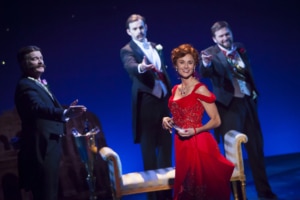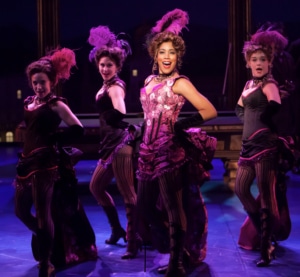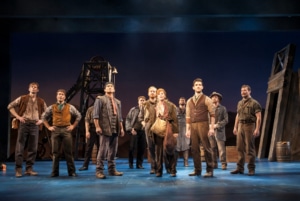DCPA NEWS CENTER
Enjoy the best stories and perspectives from the theatre world today.
Enjoy the best stories and perspectives from the theatre world today.
This article was published on September 17, 2014
Lyricist and librettist Dick Scanlan kept turning down a request to revise The Unsinkable Molly Brown, the first time from Richard Morris, the original book writer, who collaborated with Scanlan on Thoroughly Modern Millie. When the third call came from Freddy Gershon, CEO of Musical Theatre International, he turned him down as well. Scanlan lamented to his writing partner, “I feel like Molly Brown is always hanging over my head.” She reached over his head and took a photo off the wall of Richard Morris in front of the marquee for Molly Brown. “You hung it over your own head.”

(l-r) Beth Malone, John Scherer, Michael Halling and Gregg Goodbrod in The Unsinkable Molly Brown. Photo by Jennifer M. Koskinen
Doug Langworthy: When you seriously considered taking on this rewrite of The Unsinkable Molly Brown, where did you start?
Dick Scanlan: I began to research Molly Brown’s life. Very early on in that process I discovered two things. I discovered the legend of Molly Brown in Gene Fowler’s [1933] Timberline, which is a book about Denver lore that contains a four-page chapter on “The Unsinkable Mrs. Brown” that’s all apocrypha, pure myth. The other thing that I discovered was the historical Molly Brown through a [1999] biography written by Kristen Iversen [Molly Brown: Unravelling the Myth]. When I tracked Iversen down, she told me something that really touched me. All those years that J.J. Brown and Molly were separated and counter-suing each other, they were writing each other tender and intimate love letters. So this complicated relationship between these two strong people began to interest me.
Doug Langworthy: Were there aspects of Margaret’s life that you definitely wanted to include? Myths that you wanted to dispel?
Dick Scanlan: I surely wanted to dispel the myth that she was in any way stupid. It is true she was from Hannibal, Mo., and her father really was a ditch-digger for the coal company, and she really did leave school when she was 12 to work in a cigar factory. And she moved out to Leadville when she was 18 thinking there would be opportunity for her, which there turned out to be. But her parents were very big on educating yourself, and also very big on raising their kids to believe they could make something of their lives. I wanted her to be smart from the beginning of the play. I also wanted to add context to the idea that she was shunned by The Sacred 36, which isn’t untrue; she was shunned, but she wasn’t sitting alone in her house waiting for their acceptance. She was out there using her money to fund all sorts of progressive causes, which by the way was part of why she was shunned.

The cast of The Unsinkable Molly Brown. Photo by Jennifer M. Koskinen
Doug Langworthy: How historically accurate would you say your adaptation is?
Dick Scanlan: I think that you try to evoke historical accuracy, as opposed to rendering it in a slavish way. In earlier drafts there were chunks of scenes that were about the gold standard, and other things, which we pruned back. But some of it, like the way J.J. solved the problem of how to get to the gold [by using bales of hay to staunch the flow of sand], you do have to spend a little bit of time explaining what the problem is and what his solution was and why it was so risky.
Doug Langworthy: Where have the new songs for the musical come from?
Dick Scanlan: It was a strange process, because once Rosemary Willson [widow of Meredith Willson, the original composer] agreed to work with us, it took awhile for her to open up Meredith’s trunk. Initially she just said, “No, there are no songs.” I knew that couldn’t be true, but I just charged ahead and wrote a draft of the script…. Over time, singer Michael Feinstein [who has been dubbed the “Ambassador of the Great American Musical”] took Rosemary to dinner and said “Rosemary, why aren’t you letting Dick Scanlan into the trunk? How is it serving Meredith’s legacy to not let songs of his be heard that no one knows?” And so he asked her where it was, and she said in the basement, and so he stood up and said, “Come on.” And they went downstairs and she opened a filing cabinet, and there in perfect alphabetical order was every song he had ever written. Shortly after that I was able to go down to the basement and digitally photograph any song I thought could ever be used. And I came out with a catalog of about 60 songs.

The cast of The Unsinkable Molly Brown. Photo by Jennifer M. Koskinen
Doug Langworthy: How would you prepare people who have seen the original musical for this new version?
Dick Scanlan: I think it’s a very new version from a narrative perspective. It’s a very, very different story, but I think that what people remember and take away from the original musical is the essence of the character Molly Brown. She is this indomitable, fundamentally American character who has an enormous impulse to affect the world, which is a good thing, and also has an enormous need for attention, which isn’t always a good thing. We’ve not changed the essence.
Doug Langworthy: How much has this adaptation changed since you presented it at the Colorado New Play Summit five years ago?
Dick Scanlan: The first act has undergone the natural progression of a play in development — it’s a tighter, better, sharper, funnier version of what we had at the Summit. The second act, however, has been radically re-conceived. When we did it at the Summit, I felt that Act One and Act Two were two different plays. I felt in Act One we made a promise, and then in Act Two we kind of broke that promise and turned it into something else.
Doug Langworthy: What does it mean to you to premiere this show in Denver?
Dick Scanlan: I’d never worked at [or seen a show at] the Denver Center, but it was beyond a desire — it was a certainty — that this is where the show should start. And then our experience at the Summit was so positive. Kathleen Marshall, our director, Michael Rafter, our music director, and I were astonished at how well-run the theatre was. We rehearsed a week in New York, and then came to Colorado, and that worked beautifully. Then the audiences showed up in droves, and they were lively and engaged. So we felt, boy, is this a no-brainer that we do this here.
The songs: How the new Molly Brown score breaks down:
